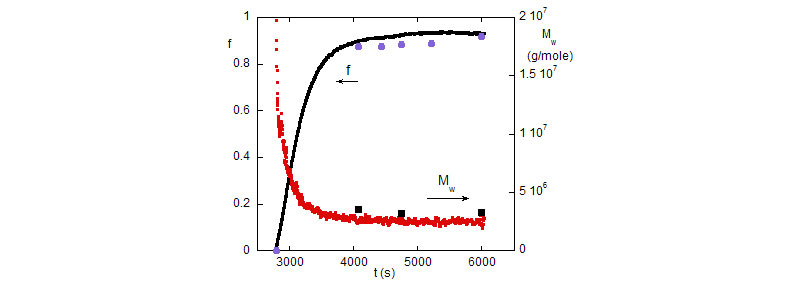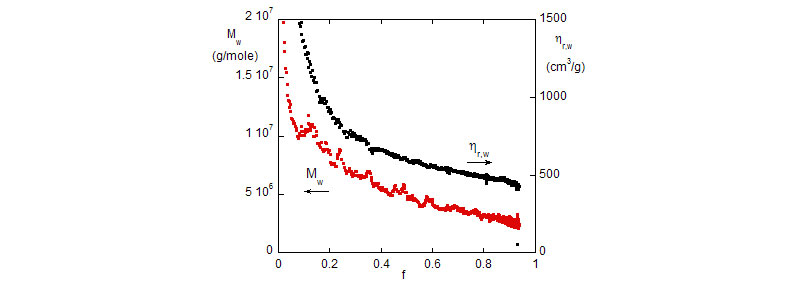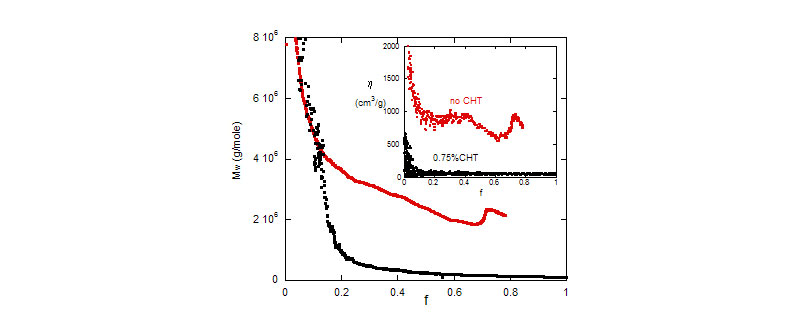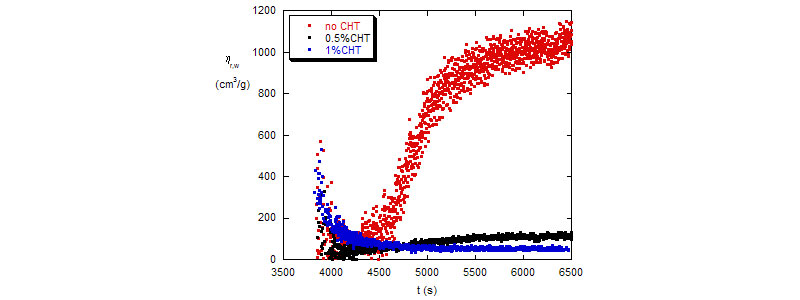1. Surfactant-free emulsion polymerization
2. Emulsion polymerization with SDS
An original idea was put in practice: use ACOMP to simultaneously measure properties of the dispersed components (emulsions) and their contents (polymer and monomer). dilute one withdrawn reactor stream with aqueous solution to preserve the dispersed (emulsion) phase and measure its characteristics online and the other withdrawn stream with THF to solubilize polymer and monomer.
A number of features are captured by this process:
• multi-phase conversion,
• multimodal mass production,
• the correlation between monomer droplet disappearance and monomer conversion,
• the reaction time and large polymer masses produced.
Publications
W. F. Reed* , A. M. Alb, "Simultaneous Monitoring of Polymer and Particle Characteristics during Emulsion Polymerization", Macromolecules (2008), 41, 2406-2414
Abstract
Emulsion polymerization reactions constitute complex, nonequilibrium systems in which there is strong interaction between polymers, monomers, and the colloidal structures that mediate the reactions. A novel and general method was sought to monitor emulsion polymerization reactions. Instrumentation and methods were hence developed here to achieve, for the first time, simultaneous monitoring of the evolving characteristics of both the organosoluble components (monomer conversion, polymer molar mass, and reduced viscosity) and the colloidal components (particle size of monomer droplets and nucleated polymer particles). No empirical models were required for these determinations. This represents a new capability for the broadening ACOMP platform (automatic continuous online monitoring of polymerization reactions). The method was applied to free radical emulsion homopolymerization of methyl methacrylate and butyl acrylate over a wide monomer concentration range, with and without surfactant stabilization. A successful approach to soap-free emulsion polymerization (up to 15% solids) was developed and led to stable and uniform emulsions with no phase separation or coagulum buildup. Trends in the polymer characteristics were cross-correlated with evolving colloid particle distributions, and the model of mass transfer from large monomer droplets (microns) to much smaller, nucleated particles which are the loci of polymerization (ca. 100 nm) was confirmed. This was seen in the disappearance of the large monomer droplets and appearance of polymer particles during monomer conversion. Results were cross-checked with offline multi-detector size exclusion chromatography, dynamic light scattering, and cryogenic transmission electron microscopy. This new ACOMP approach should be widely applicable to monitoring many types of emulsion polymerization reactions.
W. F. Reed , A. M. Alb*, "Online Monitoring of Molecular Weight and Other Characteristics during Semibatch Emulsion Polymerization under Monomer Starved and Flooded Conditions", Macromolecules (2009), 42, 8093–8101
Abstract
Reaction kinetics in semibatch emulsion polymerization of methyl methacrylate, were monitored by automatic continuous online monitoring of polymerization reactions (ACOMP). Semibatch reagent feed to the reactor at different flow rates allowed the transition between the monomer starved and flooded regimes and the approach to and maintenance of near steady state conditions to be monitored and quantified, and yielded relationships between flow regimes and monomer conversion kinetics, polymer weight-average molecular weight Mw, and intrinsic viscosity [η]w. Polymer molecular weight distributions together with latex particle size and number play an important role in defining the macroscopic characteristics and performance of polymeric materials. The change in the monomer feed rates during reaction allowed simultaneous influence on and verification of the evolution of these parameters during synthesis. When flow rate changes to the reactor were made it was verified that the characteristic rate of achieving the new pseudosteady state was close to the first order reaction rate. Multidetector size exclusion chromatography was used to cross-check results and measure full distributions of endproducts. Latex polymer size was measured with dynamic light scattering. An important advance for this field is that polymerMwis determined continuously during the reaction and in an absolute fashion, based on multiangle light scattering detection available.
Results
Surfactant-free emulsion polymerization - from dilute regime to high solid contents (14%): Soap-free emulsion polymerization of butyl acrylate (BA)
a) Polymer side:
![Raw viscosity, light scattering (90) and UV (215nm) data. [BA]=1.11M; [I]=5.586mM](/sites/default/files/rawdata1.jpg)
Left: Raw viscosity, light scattering (90) and UV (215nm) data. [BA]=1.11M; [I]=5.586mM. Right: The evolution of Mw with conversion. In the inset to figure, radius of gyration and monomer conversion, f are shown vs. time
b) Particle side:
Large monomer-containing droplets (microns) gradually cede their contents to a growing population of polymer- containing micelles of much smaller diameter (fractions of a micron)
![The evolution of the specific surface area A (upper) for two BA polymerization reactions. The volume weighted mean diameter, D[4,3] for two modes in the particle size distribution (lower) for the 14% BA](/sites/default/files/particlesize.jpg)
![Cryo-TEM image for BA surfactant–free polymerization reaction ([BA]=0.268M)](/sites/default/files/cryo.jpg)
Left: The evolution of the specific surface area A (upper) for two BA polymerization reactions. The volume weighted mean diameter, D[4,3] for two modes in the particle size distribution (lower) for the 14% BA. Right: Cryo-TEM image for BA surfactant–free polymerization reaction ([BA]=0.268M)
Emulsion polymerization with surfactant added (SDS) - from dilute regime to high solid contents (35%):
Soap-free emulsion polymerization of methy methacrylate (MMA) - polymer side
Kinetic and molar mass analysis show that free radical polymerization of MMA and BA in emulsion approximately resemble free radical polymerization in homogeneous phase, with some notable differences in details.


Left: The evolution of the fractional monomer conversion f, and the polymer mass, Mw during the polymerization reaction (0.45M). Discrete points are SEC results from manually withdrawn reaction aliquots. Right: Weight average reduced viscosity, hr,w and Mw vs. monomer conversion.
Emulsion polymerization with surfactant added (SDS) - chain transfer effect:
Emulsion polymerization of MMA and BA, respectively (~15%)


Left: MMA polymerization reactions - Mw vs. conversion for reactions with and without chain transfer agent. In the inset , reduced viscosity hr,w as functions of conversion for the same reactions. Right: BA polymerization reactions - hr,w as functions of time for reactions with different amount of transfer agent.
Emulsion Copolymerization - computing concentration of each comonomer during the reaction allows composition drift and distribution to be determined
